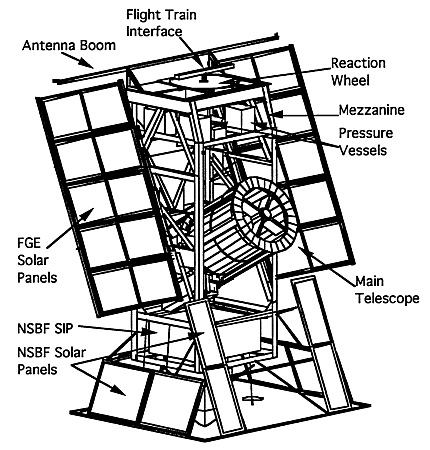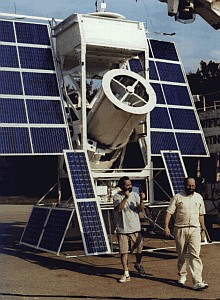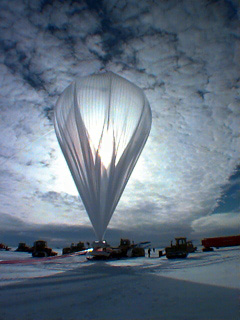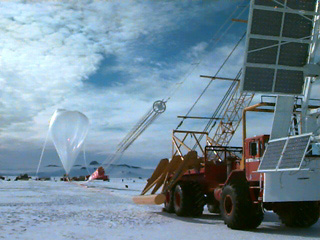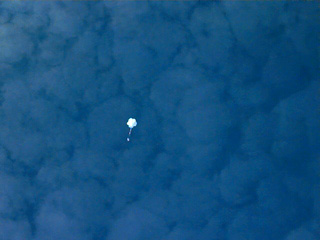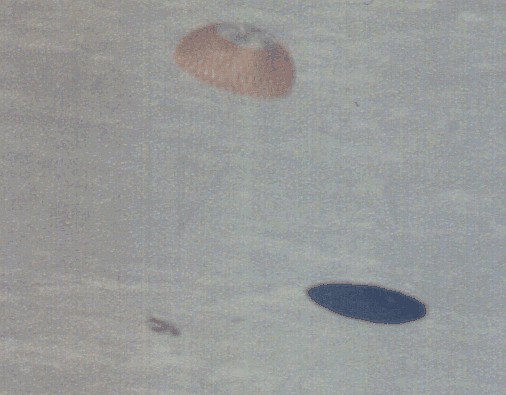Purpose of the flight and payload description
The purpose of the instrument was to improve understanding of the mechanisms involved in many different types of solar activity, particularly flares and solar filament eruptions.
The basic design of the FGE gondola was derived from a payload (Exite instrument) developed by the Harvard/Smithsonian Center for Astrophysics (CFA). The frame was bolted together from standard aluminum angle to simplify both material procurement and construction. The structure is strong enough to support the 4400-lb weight of the instrumentation, telescope, NSBF's Support Instrument Package (SIP), ballast and solar panels, even under a design load of 10 g, as well as being rigid enough to allow stable pointing to at least 10 arcsec.
The command and control electronics and the two tape drives are housed in 4 pressure vessels. The main telescope (MT), the pointing telescope (PT) , and a pressure vessel housing the optical analysis stages are mounted together and pivoted around the elevation axis, driven by a torque motor.
During this flight over 14000 images of the Sun were recorded. Achieving this goal demanded the development of a platform for an 80-cm F/1.5 optical telescope that would be stable to 10 arcseconds. The actual staility achieved was 20 arcseconds. Nevertheless, the FGE flight yielded valuable data and validated the engineering design.
Details of the balloon flight
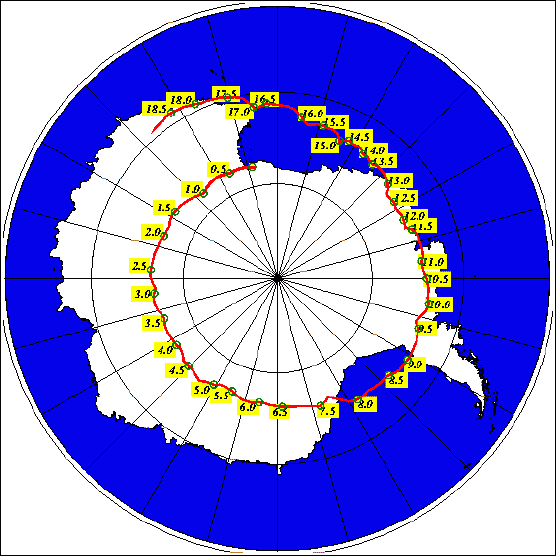
Balloon launched on: 1/7/1996 at 7:01 utc
Launch site: Williams Field, McMurdo Station, Antarctica
Balloon launched by: National Scientific Balloon Facility (NSBF)
Balloon manufacturer/size/composition: Zero Pressure Balloon SF3-424.37-080-NSC-ST
Balloon serial number: W29.47-2X-13
Flight identification number: 413N
End of flight (L for landing time, W for last contact, otherwise termination time): 1/26/1996 at 3:14 utc
Balloon flight duration (F: time at float only, otherwise total flight time in d:days / h:hours or m:minutes - ): 19 d
Landing site: 138 miles from Dumont d'Urville, Antarctica
Payload weight: 3170 lbs
Overall weight: 4763 lbs
The balloon was launched on January 7th, 1996 and after a full circumnavigation of the antarctic continent at the 17 day of flight was initiated the sequence to terminate the flight. After stowing and powered off of the payload by "over-the-horizon" command on January 24 an LC-130 flew to the vicinity of the balloon in January 26th and at 3:14 UT, the command was sent to cut down the gondola.
The balloon took about a half hour to float down to "earth", and just moments after hitting the ice, the parachute was separated. The gondola toppled onto its back with minimal damage to the solar panels. According to the GPS receiver on the LC-130, the gondola's final position was 69º3'S-141º29'E
The LC-130 not landed because the area was composed of wind-sculptured ice, between one and four feet high, capable of destroying the LC-130's skiis.
After several delays due to the difficult and risky operation of recover the whole payload so close to the season close-out a twin otter plane was able to reach the landing place at about 31th January. The pressure vessels holding the tape drives were extracted, securing the valuable data.
The rest of the payload was recovered 11 months after the flight (just before Christmas) by a team from the Institute Francais pour la Recherche et la Technologie Polaires (IFRTP). It was generally in good shape, with minor damage. The payload was sent to Dumont d'Urville, the French station on the Antarctic coast and from there by ship to Australia and back to USA.
During this flight over 14.000 images of the Sun were recorded. Achieving this goal demanded the development of a platform for an 80-cm F/1.5 optical telescope that would be stable to 10 arcseconds. The actual stability achieved was 20 arcseconds. Nevertheless, the FGE flight yielded valuable data and validated the engineering design.
External references
- Balloon-Borne Polarimetry - The Flare Genesis Experiment Solar Physics, Volume 164, Issue 1-2, pp. 403
- Conference of Andreas Andreou - Johns Hopkins University (11/18/21) about Flare Genesis Project (starting on minute 9:20) Institute for Neural Computation youtube channel
- Details on STARLAB, the former space mission cancelled that transferred its main telescope to be used in the Flare Genesis program
- Flare Genesis Experiment Proc. SPIE Vol. 2804, p. 141, Nov. 1996
- High Resolution polarimetry with a Balloon-Borne Telescope: The Flare Genesis Experiment High Resolution Solar Physics: Theory, Observations, and Techniques, ASP Conference Series #183 p.279 (1999)
- NASA Balloon Flights (1989-1998) in NASA Historical Data Book, Vol. VII: NASA Launch Systems, Space Transportation, Human Spaceflight, and Space Science, 1989-1998
- Sitio web del experimento Flare Genesis Flare Genesis Experiment website
- The Flare Genesis Experiment: studying the Sun from the stratosphere Johns Hopkins APL Technical Digest, Volume 14, Number 4 (1993)
- The Flare Genesis project Adv. Space Res. Vol. 14, No. 2, pp. (2)89, 1994
1528If you consider this website interesting or useful, you can help me to keep it up and running with a small donation to cover the operational costs. Just the equivalent of the price of a cup of coffee helps a lot.

